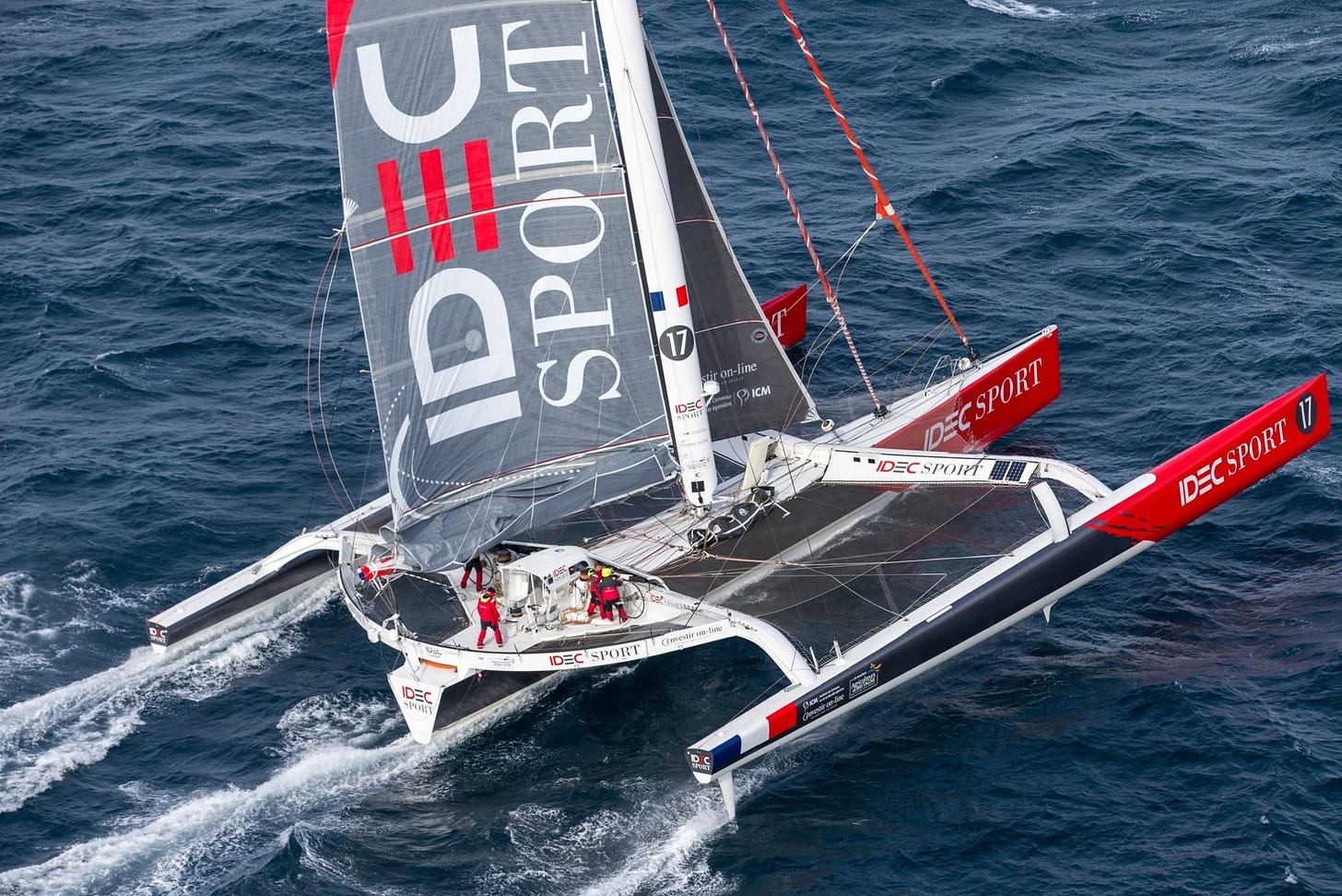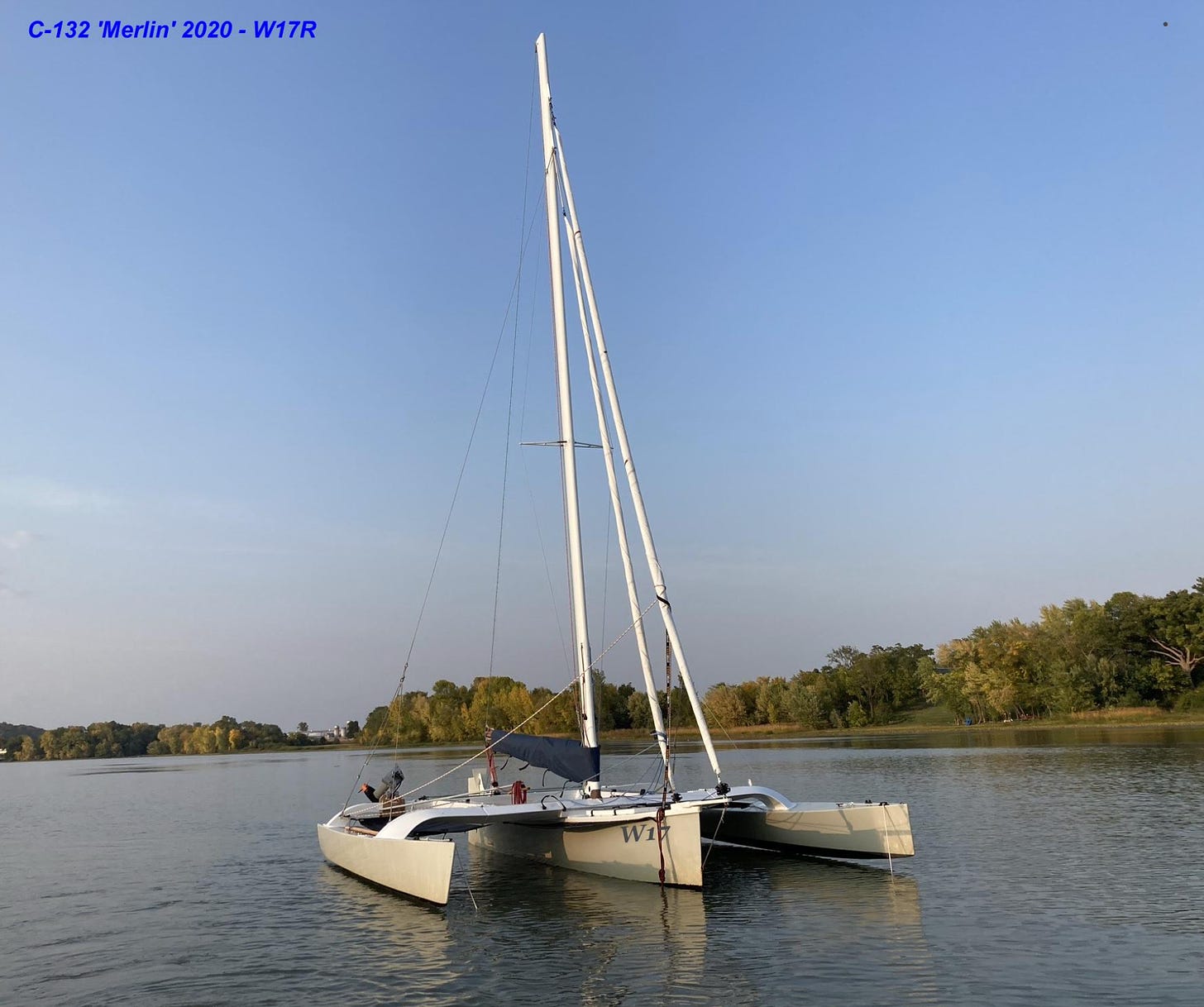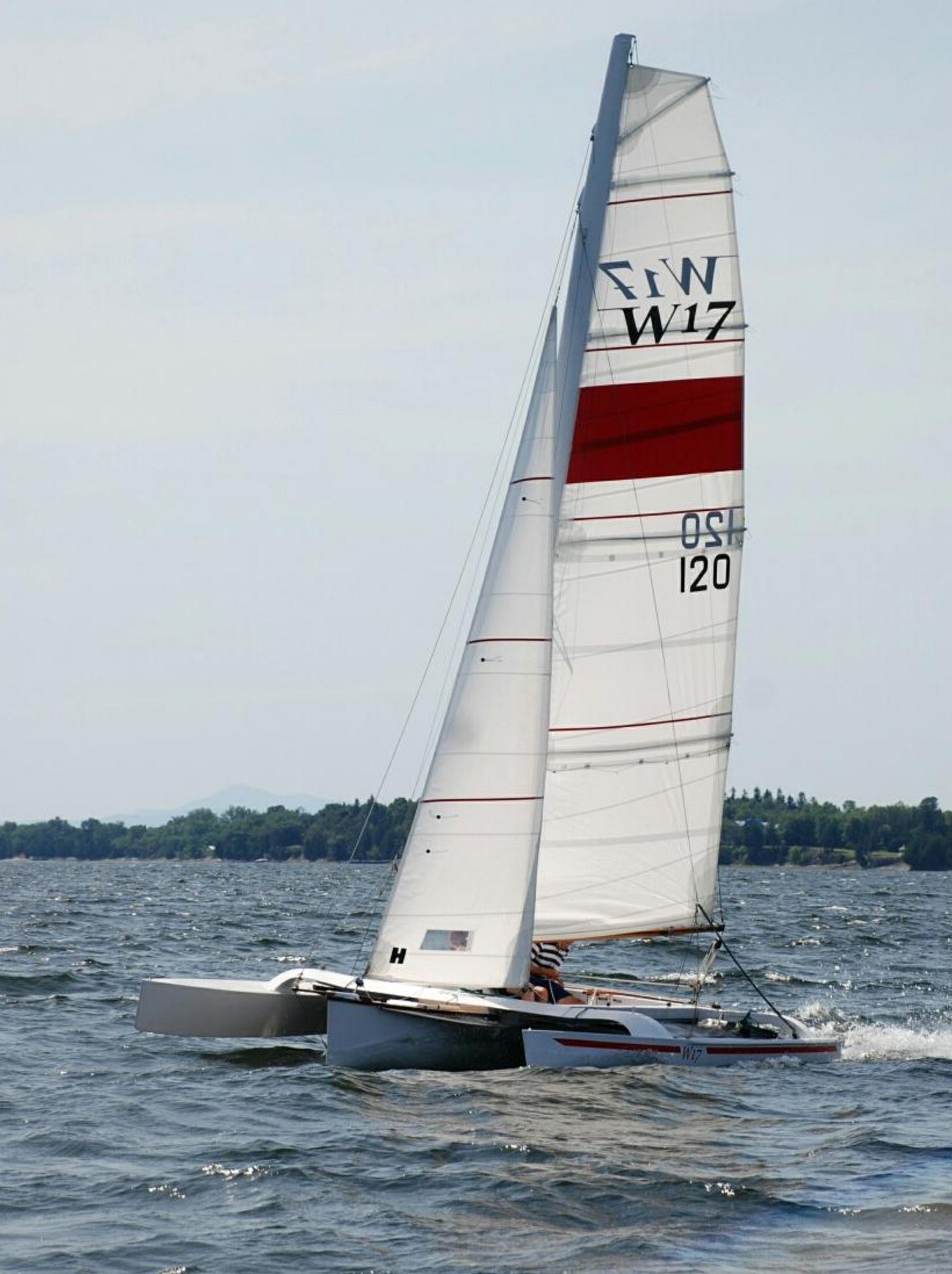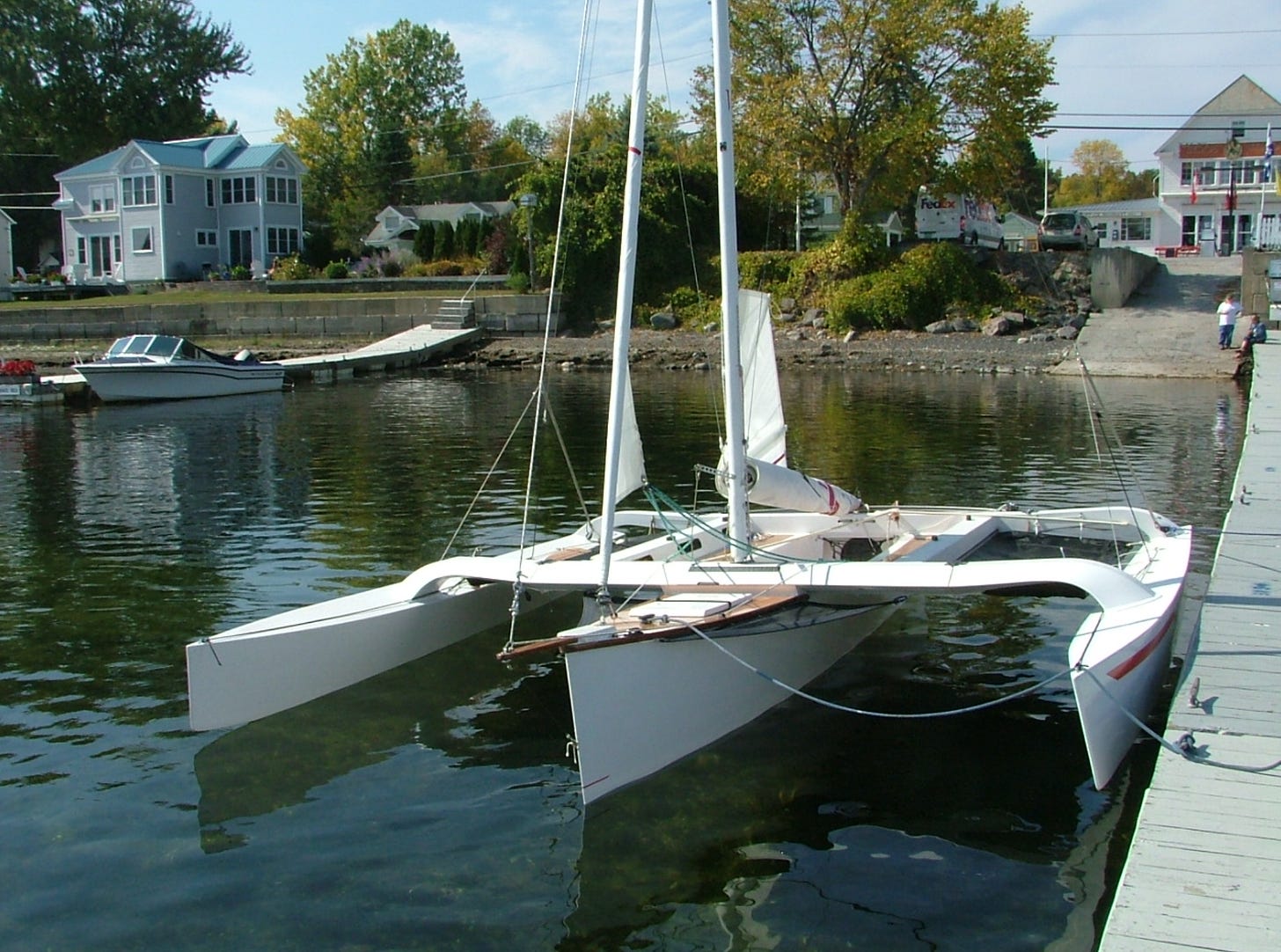


Letters and Comments on the W17 as posted by Small Craft Advisor in 2023
After many years of promoting classic, traditional monohulls as the 'go-to boats' for small trailerable cruisers, SCA finally acknowledged that there could be some advantages offered by some of the better folding trimarans as viable small trailerable cruising boats, so accepted to post this article by a trimaran enthusiast writing in from Massachusetts.
The article then brought forward a number of interesting and encouraging comments that we applaud SCA for also sharing with their subscribers. If readers have more they would like to add, please feel invited to write in to:
SCA Editor, Josh Colvin at < josh@smallcraftadvisor.com >
========================================================================================
Searching for the Ultimate Retirement Boat ?
Here is my experience...
APR 29, 2023
by Jim Van Natta
Having heard of several sailors who are close to retiring and now looking for that ultimate last boat, I thought my own experience that started 3 years ago, could be of interest. Most of us have owned bigger boats, but finally, the hassle (and perhaps cost) of layups and launchings just become too much and we yearn for a simpler experience. But in my case, I wanted a boat that still offered the thrills I once enjoyed when younger, yet with less physical stress coupled with staying drier and more comfortable At least, that was what was driving me. Small traditional boats can indeed be beautiful, but the reality is that they heel quite a lot, risk to get swamped with the associated capsize risk, and just do not have the performance I dreamed of that would allow me to travel a little farther each day,
I had sailed as a kid but then not again for many years until I was bitten fifteen years ago after we bought a cottage on Eggemoggin Reach on Little Deer Isle Maine. This must be a meca for traditional boats. I have owned several during that time including a sleek Dark Harbor 17 that I loved for her beauty and spirited sailing. She was hardly ‘low maintenance’ though, but I had great times with all my boats and learned a lot.
But as many have come to realize, true sailing pleasure is almost inversely proportional to boat size, so I decided my ideal retirement boat would be one that got me closer to the water; show an upgrade in performance and be one that did not have high cost haulouts or winter storage. This boiled down to one that was easily trailerable, yet could sit on a mooring without me worrying about constantly bailing her out. As I love woodworking projects, I also wanted the satisfaction of building this ‘retirement boat’ myself.
So I started scanning the magazines to see what caught my eye and planned my annual trip to the WoodenBoat show in Mystic, as I really have no aversion to building in wood since epoxy came out.
While web browsing, I have to admit I became captivated by the elegance and performance features of the great ocean-going trimarans of the day. Groupama 3, that was later renamed IDEC SPORT, was soon to blast around the globe to set a new Jules Verne record of just under 41 days. Those amazing boats were oozing with performance features such as long sleek amas, elegant arched beams, flat-top mainsails, rotating masts, curved mainsheet tracks, under-hull spade-rudders and fine plumb stems. The stable trimaran format also allowed IDEC to have a seemingly ridiculous SA/D ratio of 60 (compared to 20 being more the norm for a racing monohull).

So when I happened upon a magazine article review about three years ago, and saw the W17 trimaran designed by a very experienced naval architect, she hit my dream right on. “Long sleek amas, elegant arched beams, flat-top mainsail, rotating wingmast, curved mainsheet track, under-hull spade-rudder and fine plumb stems”… yikes, this boat had it all, but in a small folding and trailable package that could be home built and solo sailed, and its self-draining cockpit gave me much confidence.
Mike Waters had originally designed this boat for his own retirement and had clearly thrown everything into its creation, but there’s nothing quite like seeing and sailing a new boat yourself. So after chatting at the WB Show with an enthusiastic Geoff Kerr who had tested the boat for his WB article, I met up with Mike on Lake Champlain for a test sail and left totally convinced I had found my perfect retirement boat.
The build process was awesome and with Mike's email support when needed, I built this uniquely engineered and beautifully designed trimaran. I followed that with the construction of Mike's 8-meter rotating wingmast, which, in retrospect, was the single most rewarding phase of the entire project. It is a true wonder to me, that I was able to construct a highly engineered, strong, stiff but lightweight carbon-fiber mast without even a mold, and in my basement too!. It was the crowning achievement for me as I look back over the last three years and one that I am truly proud of.

I received the sail order for my W17 that August and was able to get out for several day sails before needing to haul the boat and travel back to Massachusetts. As these were break-in experiences for me I did not push my limits. Trimarans are new to me and I had a lot to learn about them. I had a lot to learn from a high performance, light weight sailboat as well. However, I immediately felt very secure in my new boat, whether reaching down Eggemoggin Reach or sailing out into Jericho and Penobscot bays. The narrow hull forms cut easily and efficiently into rising chop, with the occasional wave top or splash being knocked down by the bow spray nets. Already I am completely spoiled by the performance and comfort of the boat and she permits a much greater day sailing range than I was used to. Though I mainly sail with my wife who really enjoys the ride, it’s like I am single-handing when she is along, which is fine with me as I like ‘the work’ of sailing. It’s a relief that my wife feels so comfortable aboard and she enjoys to stretch out on a tramp, clearly not missing the drama of a heeling monohull.
I cannot speak directly to the performance with three or four aboard as yet, but I expect that by placing the "ballast" to the front of the cockpit or forward on the tramps that the boat would still perform admirably for a pleasurable afternoon sail. It would lack the thrill of immediate acceleration from a puff or the same efficiency from the now deeper hull forms, but it would still be a sociable, safe, comfortable and dry afternoon on the water for all.

In the fall, I had the opportunity to go out in some stronger winds, sailing on the narrow, southern end of Lake Champlain, NY in September. It gave me an excuse to try the storm mainsail and I was glad I had it as the passing front peaked. But the W17 was rock solid and it was wonderful to sail upwind at seven to eight knots (yes, you read that correctly!) under complete control and still stay remarkably dry as well. So yes, a totally different experience from monohull dinghies I have sailed, so perhaps one that other ‘retirement hunters’ might consider trying out. But be warned, not all small tris are as solid and sea-capable as this one.

Good luck to anyone with a quest to find the right sailboat. I just hope you will be as fortunate as I have been. Please let me know if you have any questions about my W17 or the build project. Being as the designer had already grabbed the most obvious name for this remarkable boat (Magic), I took the closest thing and christened her Merlin. I have already seen that most who sail her, quote her “smoothness and efficiency” and are really quite spellbound ;)
Boat information available at www.smalltridesign.com
Author’s email: vannatta.jim@gmail.com . •SCA•
=======================================================================================
COMMENTS that came in later to Small Craft Advisor
Reader Mail
A few reader letters, relative to the above article ....
Letter from reader Ron Newton (UK) regarding W17 as a “Retirement Boat':
Congratulations. Your decision to publish the excellent article by Jim Van Natta on an alternative approach to a retirement boat was instrumental in my decision to subscribe to SCA.
If I briefly describe my history you will understand why this article is so pertinent to my situation.
For the last 33 years, I have sailed, often singlehanded but accompanied by two dogs, a Dick Newick 46’ Three Cheers design which I carefully built in foam sandwich. In its day the original Three Cheers ably skippered by either Tom Follett or Mike McMullen proved to be one of the fastest ocean capable multihulls around, and after hundreds of thousands of miles in my hands the design has proved to be fast, sea-kindly and close winded, attributes associated with all designs by the legendary Dick Newick.
At the age of 77 I am now looking to downsize to something simpler and more manageable, something I can tow overland to my favourite sailing areas but there are requirements that for me are non negotiable.
In many eyes—mine included—multihulls are often ugly, but Newick’s possessed a universal elegance and any boat of mine has to look the part. The W17, with its low profile, elegant curved beams and modern rig, looks every part a modern ocean-racer in miniature and fits the bill handsomely.
Windward ability is one of the most important qualities. A close-winded boat is the fastest, it opens up more destinations and can save hours at sea. Jim has described how well his W17 is able to sail upwind in surprisingly strong conditions for such a small boat.
I have camp cruised in my Solway Dory Shearwater sailing canoe with outriggers, and recently completed an Ian Oughtred dory, but neither can provide anything like the required sailing performance, comfort and safety of the W17.
I have ordered a W17 plywood kit from Fyne Boats and look forward to the build guided by the comprehensive instruction manual supplied by the designer Mike Waters.
Letter from André Bätz (Germany) : May 23, 2023
Yesterday I read your article from Jim van Natta about the small trimaran W17. We have a very lively trimaran or multihull community in Germany and the article was well noted. Thank you for publishing. Is there more content coming about trimarans in the future?
My background: In 2015 I bought a used Farrier F82 and have taken the boat through a continuous speed optimization since then: now it has carbon amas with homebuilt lifting C-foils, a homebuilt CF rotating wing mast (Mike Waters design) with a new optimized rig, and last year I was happy to win First Multihull and First Solo Awards in a 930 nm race up the Baltic. (called Midsummersail). The competion was a bunch of bigger trimarans, potentially faster and with 3 crew members while I sailed singlehanded. I think I was driven by passion and adrenaline;)
I hope to sail my F82R for a long time still, but when I need to downsize due to my age (61 now), I definitely plan to build a W17.Best regards from André Bätz .... Juechen, Germany
.
ADDED 2023: Andre has continued to upgrade his boat with several minor tweaks, but in 2023 he achieved the unthinkable, when again up against over 75 (different) boats, he pulled off a repeat of his 2022 race results, again taking awards for First Multihull and First Singlehanded! He finished 3rd overall after battling for days against much longer racing monos. In the lighter winds given for 2023, the top four boats were so competitive that they pulled way ahead of the rest of the fleet. So much, that boat #5 was over 100 miles behind when Andre finished and a 54 footer (double the length of Andre's small tri, was 150 miles back! But it was a gruelling marathon, taking even the winners about 7 days* ... especially tough when singlehanding and only able to grab 30 mins 'sleep bites' for a full week.
* Course records were set in 2022 with the top boat (an all carbon Open 40) just coming in under 5 days.
Postscript: André Bätz wrote to me a couple of months after reading the letter from Jim van Natta and asked if it were possible to come over to try the W17 for himself. He came over late July and I took him out to meet Jim and to also sail Jim's boat in Maine. He was not disappointed and agreed to send in a report of his findings and conclusions, after sailing the two W17's daily for 3 weeks. You can now find it here.
